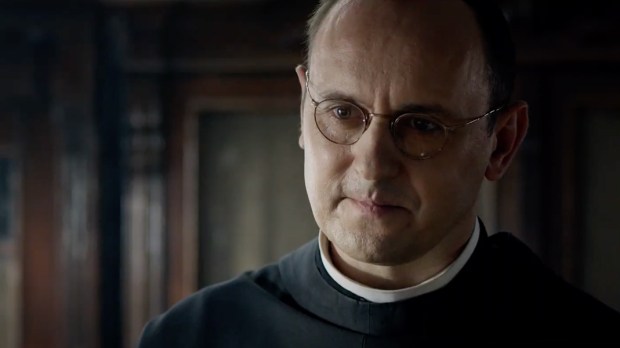For what possible reason would a future saint require 400 gallons of milk every single day? No, that’s not a set-up for a joke, it’s an honest question. If you can’t answer it, then you don’t know everything there is to know about St. Maximilian Kolbe. Not to worry though; the documentary Two Crowns is here to fill in any gaps that might exist in your knowledge of the patron saint of prisoners and the pro-life movement. Yes, it even explains the milk.
To most of us Kolbe is known primarily for his noble death at Auschwitz, where he offered his life in exchange for that of another prisoner, but that’s the very end of his earthly story. Using interviews and dramatic recreations, Two Crowns starts near the beginning in 1906, with a 12-year-old Maximilian detailing to his mother a vision he had the prior evening. In it, the Virgin Mary offered the boy two crowns, a white one representing perseverance in purity, and a red one symbolizing martyrdom. When hesitantly asked by his stunned mother which of the two crowns he chose, Maximilian simply replied, “Both.”
It would be decades before Kolbe would be driven to don the red crown, however. Before that, he made ample use of the white one. As documented in the film, Kolbe entered the seminary a mere year after his fateful vision, eventually making his way to the Pontifical Gregorian University in Rome. It was there in 1917 that Kolbe and a handful of fellow seminarians would form the Militia Immaculatae (Army of the Immaculate One), an evangelical movement whose goal was nothing less than the conversion of every single non-Catholic in the world through the intercession of Mary. Talk about “go big or go home.”
As part of Kolbe’s vision for the Militia, the group began self-publishing the Knight of the Immaculata, a monthly magazine comprised of devotionals and religious articles. Within 10 years its circulation would expand from just a few hundred issues to over 70,000. Such an endeavor obviously required many hands, so in 1927 the young priest founded a Conventual Franciscan monastery near the city of Warsaw to function as a publishing house. Over 750 seminarians would eventually join and participate in the grueling schedule required to hand-produce the magazine. Now, as one might imagine, a person could get awfully thirsty working such long days and nights. And what do you provide to 750 thirsty seminarians? 400 gallons of milk a day, apparently.
The film is full of such tidbits, which bring to life the lesser known aspects of the saint’s fascinating life story. It follows Kolbe on his missions to eastern Asia, where he would establish more monasteries and begin publishing a Japanese version of the Knight. He would also continue his work in Poland, where the Knight magazine continued to gain in popularity. At the publication’s peak, the Knight was reaching over 800,000 subscribers per month.
Of course, with such success comes much attention, and for a Catholic priest in Poland when the Nazis came to power, that could be a dangerous thing. While most of the other friars fled the country following the invasion by Germany, Kolbe and a few others remained behind. There at the monastery they provided health care to refugees, sheltered Jews from persecution, and continued to publish whatever they could, including a number of anti-Nazi tracts.
Needless to say, such efforts didn’t go over well with Poland’s new authorities. After multiple arrests failed to silence him, the now 47-year-old Kolbe was sent to Auschwitz. Kolbe’s time at the death camp is well-documented, with the film providing numerous eyewitness accounts. It’s interesting to note that while we mostly remember Kolbe’s ultimate choice to offer his life so another prisoner could be spared, those who were with the priest during those six months at Auschwitz focus more on his day-to-day acts of grace and charity, be it giving his own meager portions of food to the sick or uplifting spirits though prayer and song.
Perhaps that’s the larger point the documentary is getting at. Maximilian Kolbe’s choice to accept the red crown of martyrdom at Auschwitz is rightly commemorated as a monumental act of charity, but his decades spent wearing the white crown evangelizing through words and deeds — those times are equally worthy of praise and emulation. After all, most of us are unlikely to be offered our own red crown, but a white one? That offer stands every day.
Two Crowns will have a special showing in select theaters on October 26, 2020.

